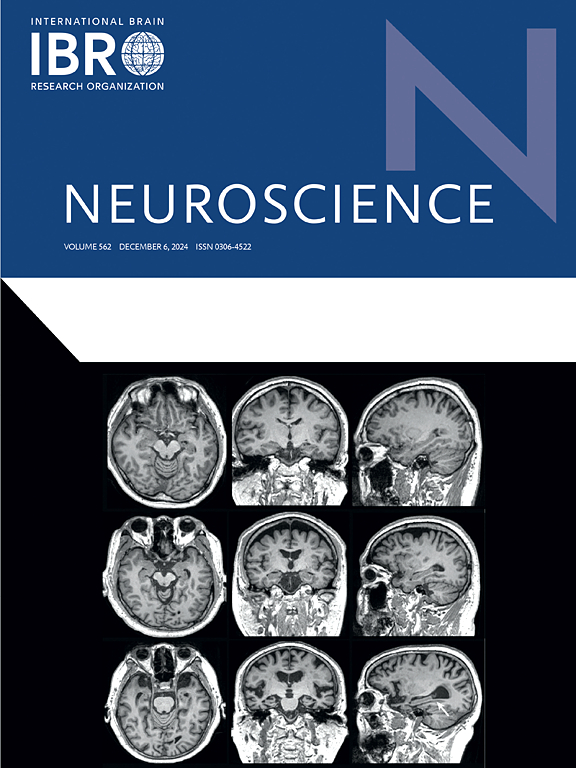神经网络退化导致小鼠听觉皮层静息和声音诱发反应的延迟变化。
IF 2.9
3区 医学
Q2 NEUROSCIENCES
引用次数: 0
摘要
神经周围网络(PNNs)是细胞外基质组件,优先覆盖新皮层中表达小蛋白(PV+)的中间神经元。PV+细胞和pnn在多种神经发育障碍中受损,包括脆性 X 综合征和精神分裂症。在这两种疾病中,脑电图(EEG)记录显示相似的表型,包括静息伽马带功率升高和40 Hz听觉稳态反应(ASSR)的时间保真度降低。PNN完整性与脑电图异常之间是否存在因果关系尚不清楚。我们通过记录pnn被酶降解(软骨素酶ABC或ChABC)的野生型小鼠听觉皮层(AC)的脑电图反应来测试这种联系。在两个不同的时间点(注射后4天或14天,横断面设计)记录脑电图。与生理盐水对照相比,注射ChABC的小鼠在4天后PNN密度降低了~ 50 %。然而,生理盐水小鼠和ChABC小鼠在静息脑电图功率谱密度、听觉事件相关电位振幅和ASSR时间保真度方面没有差异。在第14天的时间点,交流区的PNN密度恢复。有趣的是,在这个时间点,脑电图反应异常,伽马带活性升高,ASSR时间保真度降低。因此,PNN损失的电生理后果并不明显,而是在一个延迟的时间过程中出现的,这表明电路扰动后的异常可塑性。综上所述,这些数据表明听觉皮层反应的急性形成较少依赖于pnn,但电路扰动后反应的长期稳定性取决于pnn的完整性。本文章由计算机程序翻译,如有差异,请以英文原文为准。
Perineuronal net degradation causes a delayed change in resting and sound evoked responses in the mouse auditory cortex
Perineuronal nets (PNNs) are extracellular matrix assemblies that preferentially cover parvalbumin-expressing (PV+) interneurons in the neocortex. PV+ cells and PNNs are impaired in a variety of neurodevelopmental disorders including Fragile X Syndrome and schizophrenia. In both of these disorders, electroencephalograph (EEG) recordings show similar phenotypes, including elevated resting gamma band power and reduced temporal fidelity in the 40 Hz auditory steady state response (ASSR). Whether there is a causal link between PNN integrity and EEG abnormalities remains unclear. We tested this link by recording EEG responses in the auditory cortex (AC) in wildtype mice in which PNNs were enzymatically degraded (Chondroitinase ABC or ChABC). EEGs were recorded at two different time points (4- or 14-days post injection, cross-sectional design). In comparison to saline control, ChABC injected mice showed a ∼50 % reduction in PNN density after 4-days. However, there was no difference in resting EEG power spectral density, auditory event-related potential amplitudes or ASSR temporal fidelity between saline and ChABC mice. At the 14-day time point, there was a recovery of PNN density in the AC. Interestingly, EEG responses were abnormal at this time point, with elevated gamma band activity and reduced ASSR temporal fidelity. Thus, the electrophysiological consequences of PNN loss are not seen acutely, but over a delayed time course, suggesting abnormal plasticity after a circuit perturbation. Taken together, these data indicate acute shaping of auditory cortical responses is less dependent on PNNs, but long-term stability of responses following a circuit perturbation depends on the integrity of PNNs.
求助全文
通过发布文献求助,成功后即可免费获取论文全文。
去求助
来源期刊

Neuroscience
医学-神经科学
CiteScore
6.20
自引率
0.00%
发文量
394
审稿时长
52 days
期刊介绍:
Neuroscience publishes papers describing the results of original research on any aspect of the scientific study of the nervous system. Any paper, however short, will be considered for publication provided that it reports significant, new and carefully confirmed findings with full experimental details.
 求助内容:
求助内容: 应助结果提醒方式:
应助结果提醒方式:


